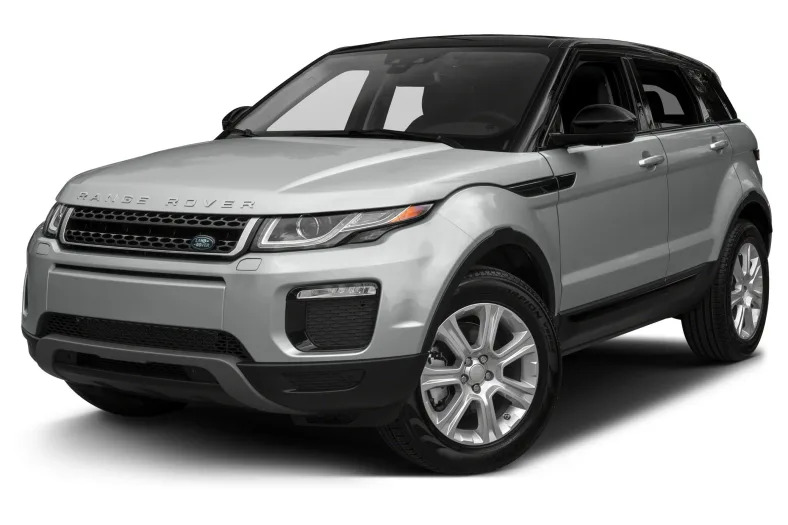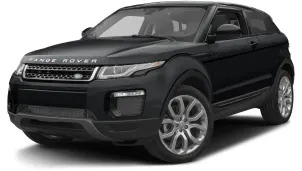Autobiography 4x4 5-Door
2017 Land Rover Range Rover Evoque
Ventriloquism on the radio, a Donald Trump charm school, or binoculars for bears are things so pointless and irrelevant they almost defy you not to like them. Range Rover's Evoque cabriolet is another. A ragtop sport utility vehicle? Oh boy, who thought that one up? And at this point, I'm really still trying to forget Nissan's unlamented Murano CrossCabriolet. "Oh ja, the car we all really need," joked one German PR representative when the Evoque cabrio broke cover last year, though the joke was on the other foot at the Geneva Show in March, when VW debuted the T-Cross Breeze concept, a design so astonishingly similar to the Evoque's, you wonder why Land Rover hasn't taken legal counsel. The Evoque is, of course, Land Rover's surprise hit of the 21st century. It all started in the Motor City in 2008, the year of Land Rover's 60th anniversary. In celebration, the company produced the Land Rover LRX, a wedge-shaped SUV hybrid designed by Julian Thompson, with a sumptuous cabin by Mark Butler. It was this car that became the 2011 Evoque, based on the Freelander 4x4 chassis, with new independent suspension, Ford four-cylinder engines, and "RANGE ROVER" spelt across the bonnet. This was a kind-of boutique, concept car for the road. Its flaws were manifest: cramped rear seats, high curb weight despite lots of aluminum coachwork, a really high sticker price, and a lot less technology than the LRX had initially promised. But East and West Coast urbanites tore each others' eyes out for it. And like the first Renault Scenic, or the Mazda MX-5 when they were new, the Evoque had no competitors; if you wanted an Evoque, you had to go to Land Rover. Remove the roof, add strengthening, and the Convertible weighs 615 pounds more that the standard three-door Evoque. Land Rover has struggled to meet demand for its baby Rangey ever since. Currently its Halewood plant near Liverpool works a three-shift, 24-hour-a-day operation to slake the world's thirst for the Evoque and the new Discovery Sport. In February, the half millionth Evoque rolled out of end-of-line inspection and like any other premium manufacturer, Land Rover needs to keep the public interest boiling with new models, colors and, um, this two-door cabriolet. Clearly, cutting the aluminum roof off a car never designed initially as a cabriolet demands some planning and substantial chassis reinforcement. So while the Evoque Convertible goes on sale in the States this summer (prices start at $50,475) it is currently in what is known as "ramp up" at Halewood, where a new car pops off the line every 80 seconds. To cope with the additional assembly required, the cabrio spends an additional 26 minutes on a circular siding off the main production line, while a specially trained team of six fit the Webasto-made folding top assembly and 441 pounds of underbody strengthening including reinforcement for the A and B pillars, diamond braces under the body, and an all-steel sump guard. Remove the roof, add strengthening, …
Full Review
Ventriloquism on the radio, a Donald Trump charm school, or binoculars for bears are things so pointless and irrelevant they almost defy you not to like them. Range Rover's Evoque cabriolet is another. A ragtop sport utility vehicle? Oh boy, who thought that one up? And at this point, I'm really still trying to forget Nissan's unlamented Murano CrossCabriolet. "Oh ja, the car we all really need," joked one German PR representative when the Evoque cabrio broke cover last year, though the joke was on the other foot at the Geneva Show in March, when VW debuted the T-Cross Breeze concept, a design so astonishingly similar to the Evoque's, you wonder why Land Rover hasn't taken legal counsel. The Evoque is, of course, Land Rover's surprise hit of the 21st century. It all started in the Motor City in 2008, the year of Land Rover's 60th anniversary. In celebration, the company produced the Land Rover LRX, a wedge-shaped SUV hybrid designed by Julian Thompson, with a sumptuous cabin by Mark Butler. It was this car that became the 2011 Evoque, based on the Freelander 4x4 chassis, with new independent suspension, Ford four-cylinder engines, and "RANGE ROVER" spelt across the bonnet. This was a kind-of boutique, concept car for the road. Its flaws were manifest: cramped rear seats, high curb weight despite lots of aluminum coachwork, a really high sticker price, and a lot less technology than the LRX had initially promised. But East and West Coast urbanites tore each others' eyes out for it. And like the first Renault Scenic, or the Mazda MX-5 when they were new, the Evoque had no competitors; if you wanted an Evoque, you had to go to Land Rover. Remove the roof, add strengthening, and the Convertible weighs 615 pounds more that the standard three-door Evoque. Land Rover has struggled to meet demand for its baby Rangey ever since. Currently its Halewood plant near Liverpool works a three-shift, 24-hour-a-day operation to slake the world's thirst for the Evoque and the new Discovery Sport. In February, the half millionth Evoque rolled out of end-of-line inspection and like any other premium manufacturer, Land Rover needs to keep the public interest boiling with new models, colors and, um, this two-door cabriolet. Clearly, cutting the aluminum roof off a car never designed initially as a cabriolet demands some planning and substantial chassis reinforcement. So while the Evoque Convertible goes on sale in the States this summer (prices start at $50,475) it is currently in what is known as "ramp up" at Halewood, where a new car pops off the line every 80 seconds. To cope with the additional assembly required, the cabrio spends an additional 26 minutes on a circular siding off the main production line, while a specially trained team of six fit the Webasto-made folding top assembly and 441 pounds of underbody strengthening including reinforcement for the A and B pillars, diamond braces under the body, and an all-steel sump guard. Remove the roof, add strengthening, …
Hide Full Review
Hide Full Review
Retail Price
$62,500
MSRP / Window Sticker Price
| Engine | 2.0L I-4 |
| MPG | 21 City / 29 Hwy |
| Seating | 5 Passengers |
| Transmission | 9-spd auto w/OD |
| Power | 240 @ 5500 rpm |
| Drivetrain | Terrain Response four-wheel |
Smart Buy Program is powered by 




